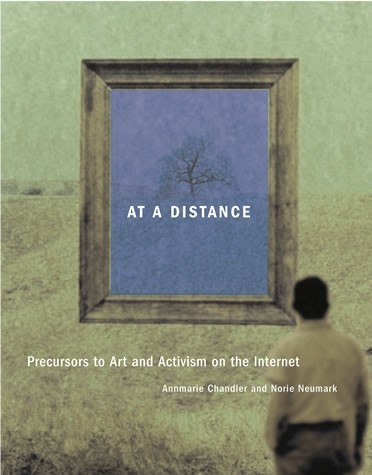Jeffrey Skoller: Shadows, Specters, Shards. Making History in Avant-Garde Film (2005)
Filed under book | Tags: · 1970s, 1980s, 1990s, avant-garde, cinema, experimental film, film, film history, film theory

Demonstrates how avant-garde films better reflect the complexity of history than conventional film.
Avant-garde films are often dismissed as obscure or disconnected from the realities of social and political history. Jeffrey Skoller challenges this myth, arguing that avant-garde films more accurately display the complex interplay between past events and our experience of the present than conventional documentaries and historical films.
Shadows, Specters, Shards examines a group of experimental films, including work by Eleanor Antin, Ernie Gehr, and Jean-Luc Godard, that take up historical events such as the Holocaust, Latin American independence struggles, and urban politics. Identifying a cinema of evocation rather than representation, these films call attention to the unrepresentable aspects of history that profoundly impact the experience of everyday life. Making use of the critical theories of Walter Benjamin and Gilles Deleuze, among others, Skoller analyzes various narrative strategies—allegory, sideshadowing, testimony, and multiple temporalities—that uncover competing perspectives and gaps in historical knowledge often ignored in conventional film. In his discussion of avant-garde film of the 1970s, 1980s, and 1990s, Skoller reveals how a nuanced understanding of the past is inextricably linked to the artistry of image making and storytelling.
Publisher University of Minnesota Press, 2005
ISBN 081664232X, 9780816642328
233 pages
PDF (updated on 2012-7-14)
Comment (0)Alex Roland, Philip Shiman: Strategic Computing: DARPA and the Quest for Machine Intelligence, 1983-1993 (2002)
Filed under book | Tags: · 1980s, arpanet, artificial intelligence, computing, expert systems, history of computing, history of technology, technology

“This is the story of an extraordinary effort by the U.S. Department of Defense to hasten the advent of “machines that think.” From 1983 to 1993, the Defense Advanced Research Projects Agency (DARPA) spent an extra $1 billion on computer research aimed at achieving artificial intelligence. The Strategic Computing Initiative (SCI) was conceived as an integrated plan to promote computer chip design and manufacture, computer architecture, and artificial intelligence software. What distinguished SCI from other large-scale technology programs was that it self-consciously set out to advance an entire research front. The SCI succeeded in fostering significant technological successes, even though it never achieved machine intelligence. The goal provided a powerful organizing principle for a suite of related research programs, but it did not solve the problem of coordinating these programs. In retrospect, it is hard to see how it could have.
In Strategic Computing, Alex Roland and Philip Shiman uncover the roles played in the SCI by technology, individuals, and social and political forces. They explore DARPA culture, especially the information processing culture within the agency, and they evaluate the SCI’s accomplishments and set them in the context of overall computer development during this period. Their book is an important contribution to our understanding of the complex sources of contemporary computing.”
Keywords and phrases
DARPA, expert systems, Teknowledge, Connection Machine, Shiman, Robert Kahn, supercomputers, ARPA, IntelliCorp, Artificial Intelligence, Lynn Conway, VLSI, ARPANET, Alex Roland, U.S. Congress, Saul Amarel, CPSR, George Heilmeier, Xerox PARC, Craig Fields
Publisher MIT Press, 2002
ISBN 0262182262, 9780262182263
427 pages
PDF (updated on 2012-7-25)
Comment (1)Annmarie Chandler, Norie Neumark (eds.): At a Distance: Precursors to Art and Activism on the Internet (2005)
Filed under book | Tags: · 1970s, 1980s, activism, art history, experimental art, fluxus, mail art, media art, network art, network culture, networks, new media, radio art, telematics

“Networked collaborations of artists did not begin on the Internet. In this multidisciplinary look at the practice of art that takes place across a distance—geographical, temporal, or emotional—theorists and practitioners examine the ways that art, activism, and media fundamentally reconfigured each other in experimental networked projects of the 1970s and 1980s. By providing a context for this work—showing that it was shaped by varying mixes of social relations, cultural strategies, and political and aesthetic concerns—At a Distance effectively refutes the widely accepted idea that networked art is technologically determined. Doing so, it provides the historical grounding needed for a more complete understanding of today’s practices of Internet art and activism and suggests the possibilities inherent in networked practice.
At a Distance traces the history and theory of such experimental art projects as Mail Art, sound and radio art, telematic art, assemblings, and Fluxus. Although the projects differed, a conceptual questioning of the “art object,” combined with a political undermining of dominant art institutional practices, animated most distance art. After a section that sets this work in historical and critical perspective, the book presents artists and others involved in this art ‘re-viewing’ their work—including experiments in ‘mini-FM’, telerobotics, networked psychoanalysis, and interactive book construction. Finally, the book recasts the history of networks from the perspectives of politics, aesthetics, economics, and cross-cultural analysis.”
Publisher MIT Press, 2005
ISBN 0262033283, 9780262033282
xiv+486 pages
Reviews: Publishers Weekly (2005), Vincent Bonin (2005), Graham Meikle (Scan, 2006), Paolo Gerbaudo (Culture Machine, 2006), Joel Slayton (Art Book, 2006), Karrie Karahalios (New Media & Society, 2006), Jennifer Way (RCCS, 2008, with responses from editors).
PDF (updated on 2019-11-22)
Comments (3)
